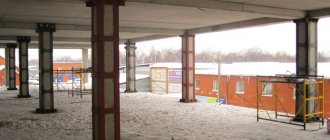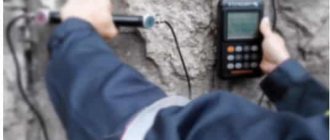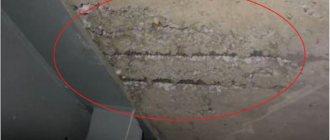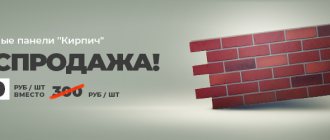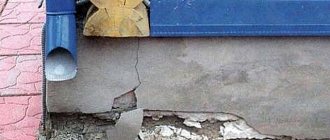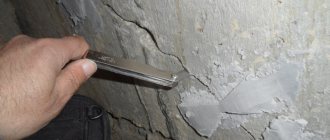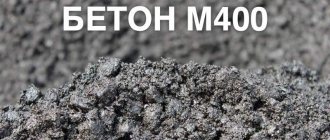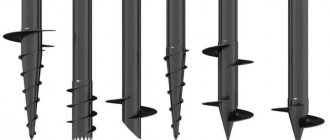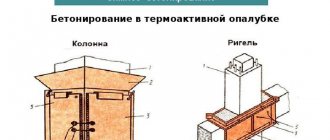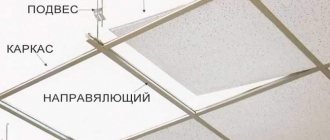Methods of strengthening structures, buildings and structures
Concrete materials have been used in construction for more than four thousand years; for the last few centuries, this material has been supported by iron, but this does not help protect it from unfavorable external environments and disasters. In Russia alone, today, there are thousands of houses made of reinforced concrete that require structural reinforcement. The most progressive and economical way is to strengthen it with carbon fiber.
At the moment, there are only 3 main ways to strengthen structures:
- Traditional or standard.
- Innovative or technological.
- Combined.
The traditional method - first of all, upholstery occurs, concrete layers are applied to increase the cross-sectional area. Next, rolled steel is used, installation of metal tie rods, and reinforcement of holes with angles or channels. The installation of additional elements to strengthen columns and floors is being completed, and spacers or piles are being installed.
An innovative method - this method of strengthening structures is based on the use of composites. Its essence lies in gluing carbon fiber in layers onto load-bearing surfaces. Because of this, the dimensions of the room do not change; the thickness of the material does not exceed a few millimeters.
The combined method is a method of working to fill all cracks and cavities with material. This method helps to permanently connect the disparate parts of the structure. The work is done using various mixtures.
The third method (combined) is suitable for strengthening reinforced concrete structures. Thus, traditional and innovative methods are combined.
Basic methods of strengthening concrete objects
Reinforcement with carbon sheets is based on two methods:
Innovative - a method that has been mentioned more than once in the text (divided into “dry” and “wet” methods). It involves using a composite material (carbon, carbon fiber or Kevlar) using adhesives to create a strong bond. By fixing, usually with cementitious materials.
Combined – from the name itself it is clear that it combines several methods. Of these, innovative and traditional. The second method is to increase the strength level by using materials other than carbon fiber. Such materials are less convenient in construction, since they weigh relatively more. Thus, the combined method is to use carbon sheet and other reinforcing materials. This method is usually used in high-load areas.
What you should pay attention to when creating a strengthening project:
- First of all, you should pay attention to the results of the analysis and examination of the structure. Such an analysis is carried out in the case of visible defects, when the level of strength decreases.
- What is the lifespan of the building? Old structures are more susceptible to destruction.
- It is necessary to collect information about the soil on which the construction of the facility is planned. It is important to indicate whether there are bodies of water that could create flooding, other existing natural features (aggressive influence of external factors)
- Information about emergency situations, provisions. It is necessary to indicate any existing defects.
- Actual characteristics of all materials used (concrete, steel, etc.).
- Information about previously enhanced parts.
- Data on possible increasing loads.
Why should you choose carbon fiber?
First of all, it’s worth understanding what carbon fiber is. Carbon fiber is a composite made up of carbon strands that are approximately 5-15 microns thick. This method of strengthening architectural structures appeared in 1998. The material takes on most of the effort.
How is it different from others? Carbon fiber is several times superior to materials such as structural steel, aluminum, and common alloys in terms of physical and mechanical parameters.
Positive properties of carbon fiber:
- heat resistance;
- resistance to shock and chemical environmental conditions;
- service time is almost unlimited;
- applied in several layers, if necessary;
- during construction, it is not necessary to stop the operation of the entire building;
- material weight;
- strength of the material.
Thus, any structure will last much longer using carbon fiber in construction. Carbon fiber copes well with all its tasks, without changing the structure of the building itself. The strengthening process itself takes place quite quickly and does not require large-scale preparatory actions.
Preparation of components
Carbon materials are sold wound and packaged in special protective polyethylene. Dust must not be allowed to enter, which will be sufficient after grinding the concrete, otherwise the carbon fiber will not be glued using resin-based construction adhesive, i.e., a manufacturing defect will result. Therefore, the procurement area should be covered with dense polyethylene and the required length of carbon material should be unrolled along it. Cutting carbon tapes and meshes can be done with a regular knife or metal scissors, and carbon lamellas can be cut with an angle grinder with a metal cutting wheel.
Adhesives can, as a rule, be two-component - that is, it is necessary to combine two materials in certain quantities. It is necessary to carefully listen to the manufacturer's instructions and use special scales or a volumetric flask when mixing elements. Combining elements consists of gradually adding one component to another, with continuous mixing with a drill at low speeds. Dosing errors, or incorrect addition of one element to another, can lead to boiling of the glue. Recently, for about several years, most specialists send adhesive in kits - that is, in two containers with already dosed volumes of components. Thus, it became possible to simply mix the contents of one container into another (for this purpose the container is sent half-empty) and obtain a ready-made adhesive composition.
Construction adhesives (for carbon fiber) are supplied in bags and sealed with water according to the instructions, like any repair material. Remember that the binder has a limited lifespan - about 35-45 minutes, and it is sharply reduced when the temperature rises above 22 ° C, so the volume of the prepared adhesive should not exceed the physical capabilities of its production.
Reinforcement technologies with carbon fiber
There are 3 technologies for strengthening reinforced concrete structures using carbon fiber (carbon fiber):
- Application of carbon fiber tapes (strengthening bridges and superstructures).
- Use of carbon fiber scrims (used to strengthen beams, crossbars, holes and columns). The main advantage of canvases is their flexibility; they can be easily given the desired shape.
- The use of carbon fiber mesh (most often used when working with reinforced concrete structures). Such meshes are fireproof.
Our guarantees
Only a company that is confident in the level of services gives serious guarantees. REINFORCE has such confidence, which is why we provide a guarantee of up to 5 years for all work performed.
3 carbon fiber reinforcement technologies practiced by REINFORCE
There are quite a lot of reinforcement options when using a composite material, namely carbon fiber. Which of the three types of amplification to choose is determined by the specifics of the task.
- Carbon fiber tapes with epoxy adhesive
are used in the case of extended objects, such as bridges and long spans. It’s not surprising, because the roll length reaches 250 linear meters. This is a material of high rigidity and excellent load-bearing capacity. - Carbon scrims with epoxy adhesive
are used to strengthen columns, beams, beams, slabs, openings, and other civil engineering elements. They can be given almost any shape due to the good flexibility of the material. - Carbon fiber mesh with cement binder.
Their areas of application are strengthening masonry, brick and stone, and reinforced concrete. Such meshes have fire-resistant qualities, high vapor permeability and, of course, excellent strength.
Work process in stages
Strengthening a reinforced concrete surface may be required when the integrity of the structure is compromised, the load increases, or to increase seismic resistance.
Before starting reinforcement, builders are required to perform a number of additional procedures, without which it will not be possible to complete the reinforcement efficiently.
The cost of work to strengthen a reinforced concrete structure is based on the results of calculations carried out on the basis of an examination of load-bearing structures and identification of deficiencies in its capabilities. It must be remembered that we are talking about critical construction operations, for which it is important to have certain design skills and have fairly high qualifications for the correct calculation of the entire process.
Strengthening a reinforced concrete structure or building
The work can be done in two ways: “dry” or “wet”. Each method involves treating the material with a special binder - adhesive. They differ only in the sequence of use of the adhesive: in the first case, it is applied to the material, in the second case, to the surface of the building, and the material is applied to it.
Carbon fiber is applied in layers to the surface; no more than two layers can be applied in one shift (day), otherwise they will not have time to dry and the work will be defective. Each layer of material is rolled with a roller, it must dry completely and harden, after which a new one is applied. Other activities may also be required for the job. These include the elimination of faults and defects using injection or gluing of individual elements. In general, everything that is necessary to reconstruct the integrity of the building.
Strengthening structures using carbon fiber reinforced plastic
Composite options, which include working with carbon fiber, are divided into three types:
1. Carbon fiber tapes with epoxy resin glue - they are used to strengthen the structures of bridges and buildings with long spans (a roll contains 250 linear meters of material, which has exceptional rigidity and high load-bearing capacity);
2. Carbon canvases with epoxy glue - used for beams, crossbars, columns, various floors and other construction elements, the canvases are flexible, due to which they can be applied to any surface;
3. Carbon fiber mesh with a cement bond - used for brick or stone masonry, has also shown itself to be good for reinforced concrete structures, has high fire resistance and vapor permeability.
How does strengthening reinforced concrete structures differ from others?
Despite the fact that reinforced concrete is the main material in construction, it is stable to static dynamic forces, its main disadvantage or main disadvantage is too much weight. Strengthening reinforced concrete structures should not increase the weight and original geometry. And carbon fiber materials meet this basic condition; their mass is completely imperceptible for buildings.
Strengthening a reinforced concrete structure allows you to achieve the following goals:
- The cracks are sealed.
- Removes deflections and other deformations that appear over time.
- Protection against corrosion and other external factors (temperature, moisture, etc.)
- Increasing seismic resistance.
When working with a structure, first of all, pay attention to the condition of the reinforcement. If it leaves its place and self-destructive formations (corrosive formations) appear, they must be removed immediately, otherwise the building may collapse from the inside. Also, when determining the direction of laying the carbon composite on the surface to be strengthened, the direction of the existing steel reinforcement should be taken into account. This will allow the forces to be correctly distributed and ensure the required load-bearing capacity.
STRENGTHENING BEAMS AND BEAMS
Beams and crossbars are bendable elements of a building structure designed to carry (mainly) vertical loads. Beams are used in the construction of floors in multi-story buildings, as part of the supporting structure in one-story buildings, in the construction of bridges, overhead transport routes, etc.
Task
If the strength or rigidity of the beam is insufficient, its deformation occurs, which is not provided for by the design calculations. As a result, the edge stress increases, and the deformation process develops even more. This leads to the fact that the beam ceases to fulfill its structural purpose (at best) or collapses (at worst). This directly affects the safety of the entire facility. To eliminate the risk of destruction of the entire structure, the beams must be strengthened.
Solution
There are over 30 ways to strengthen beams, among which the most common are increasing the section of the beam from below, installing external sheet reinforcement, angles or trusses, as well as installing unloading racks, frames, struts or brackets.
All these methods, despite their active use in construction, have a number of significant disadvantages. They increase the weight of the structure, have relatively low corrosion resistance and require significant preparatory work, in particular, the construction of working platforms and scaffolding.
Reinforcing beams with carbon fiber - a new high-quality solution
One of the new technologies in construction - strengthening beams with composite materials - allows you to avoid all these difficulties. Although this method is more expensive, the reduction in labor costs, time and durability of the reinforcement offset the price of carbon fiber.
The essence of the method is very simple: carbon canvases are installed on stretched areas along the direction of the main reinforcement. And to absorb the transverse load and secure the reinforcement (anchoring), transverse bands are installed. The maximum effect of carbon fiber reinforcement for beams is achieved at a level of 2.2-2.5 times. In the diagram below you can see a typical reinforcement of a beam with carbon fiber:
Comparison of traditional methods and beam reinforcement with carbon fiber reinforced plastic
| Composites | Traditional methods | |
| Advantages | — Very high corrosion resistance; — Low weight of carbon fiber (about 230 g/sq. meter), which does not add load to the structure — The thickness of the carbon fiber plate is about 1 mm, which makes its influence on changes in the cross-sectional area of the beam and the internal dimensions of the room insignificant; — Versatility (the method can be applied to most materials, including concrete, steel, reinforced concrete and wood); — Does not require serious installation and complex installation work - a special glue is enough for connection. — Extremely high fatigue resistance | — Relatively low cost of materials; — High strength, including fatigue. |
| Flaws | — High cost of materials. | — Relatively low corrosion resistance; — Considerable weight; — High labor costs; — The need for site development, scaffolding and other preparatory work; — The need for complex installation of reinforcing structures; — Used only to strengthen concrete structures. |
Carbon fiber can be used to strengthen monolithic and reinforced concrete beams of various sections (square, I-beams, etc.), crossbars and almost any type of floor. You can evaluate the result of this method in the test video:
SDT company - proven solutions for strengthening structures
The SDT company offers services for strengthening beams, crossbars and floors with carbon fiber. Because the:
- We have successfully completed over 30 similar projects
- Engineers undergo regular internships in Europe
- The most modern materials are used in the work
You will receive the optimal reinforcement design to solve your problem and its implementation at an affordable cost. We provide a contractual guarantee for a period of 5 years - floors, beams and crossbars will be reliably protected from deformation and destruction.
General procedure
- Examination of the beam, carrying out the necessary calculations and identifying places that need strengthening;
- Drawing up a strengthening project and final estimate;
- Cleaning the beam from all particles (cement, dust, oils, etc.) that interfere with strong adhesion;
- Carrying out repairs - sealing cracks and gaps, eliminating defects;
- Applying adhesive glue to the surface;
- Installation of carbon fiber;
- Applying a sealing layer;
- Sprinkling the surface with quartz sand for high adhesion of finishing materials (produced at the request of the client).
| Beam before reinforcement: | Beam after reinforcement: |
Timing and cost
The final cost estimate is prepared by our expert after examining your property. The price of the service consists of the area of the reinforced surface, the materials used and the total amount of work. The cost of carbon fiber reinforcement starts from 3,000 rubles per square meter and depends on the density of the material, which varies from 150 to 650 g/sq.m. meter. The period for strengthening a surface with an area of 500 square meters is 14 days, and 2000 square meters - 30 days.
To get detailed advice and call our specialist to the site, contact us by phone +7 . We will be glad to see a new partnership!

